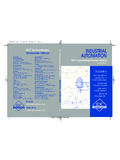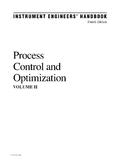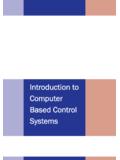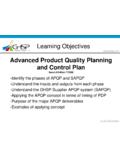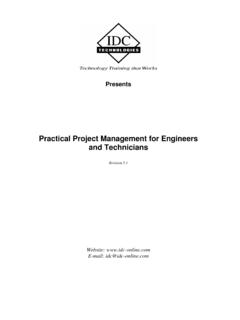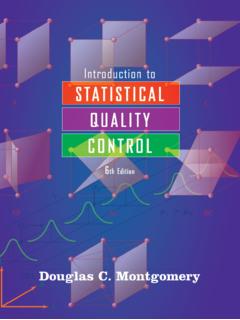Transcription of Failure Mode Effects Analysis Advanced - ASQ …
1 9/29/2010 kas1 Advanced Failure Mode Effects AnalysisImprove Quality and EfficiencyKathleen Stillings CPM, CQE, CQA, MBB9/29/2010 kas229/28/10 Kathleen StillingsToday s Goals Understand what an Advanced Failure modes and Effects Analysis is [3] Understand behavior modeling Apply the three phases of AFMEA: Identify, Analyze, and Act using behavior modeling to link behaviors and components.[3]9/29/2010 kas339/28/10 Kathleen StillingsRefresher FMEA What is it? Used to assure that potential product Failure modes and their associated causes have been considered and addressed in the design or manufacturing processIt s about taking steps to counteract or least minimize risksThe process typically begins with identifying Failure modes , the ways in which a product, service, or process could fail.
2 A project team examines every element, starting the the inputs and working through the output delivered to the customer. We continually ask what could go wrong at each are a few simple examples of Failure modes related to the process of providing hot coffee at a truck stop:One of the inputs to that process is a "clean coffee pot." What could go wrong? Perhaps the water in the dishwasher is not hot enough, so the coffee pot is not really clean. The first step in the process is to fill the brewing machine with water. What could go wrong? Perhaps the water is not the right temperature or the staff puts in too much or too little.
3 An output from the process is a hot cup of coffee delivered to the customer. What could go wrong? The coffee could get too cool before it is course, all failures are not the same. Being served a cup of coffee that is just hot water is much worse than being served a cup that is just a bit too cool. A key element of FMEA is analyzing three characteristics of failures:How severe they are How often they occur How likely it is that they will be noticed when they occurTypically, the project team scores each Failure mode on a scale of 1 to 10 or 1 to 5 in each of these three areas, then calculates a Risk Priority Number (RPN):RPN = (severity) x (frequency of occurrence) x (likelihood of detection)9/29/2010 kas449/28/10 Kathleen StillingsWhat does the FMEA do for us?
4 Reduces the likelihood of Customer complaints Reduces maintenance and warranty costs Reduces the possibility of safety failures Reduces the possibility of extended life or reliability failures Reduces the likelihood of product liability claimsProvides the tool to help the team (whether management, operators, or customers) focus on improvement efforts that pertain the failures that will have the biggest impact on customers. The highest scoring Failure modes are those that happen frequently. They are bad when they do happen and a unlikely to be detected. These are the nonconformances that get through the important items to address while working through CAPA: How did this happen?
5 , How did it get out to the Customer?, What systemic Failure allowed for the nonconformance in the first place? The FMEA will provide for a mechanism to address each of these in mind to properly maintain the FMEA: update after product changes, update after process changes, review and update if needed after nonconformances are reported by kas559/28/10 Kathleen StillingsPhases of the FMEA Identify what is the input for the FMEA? Functions or items identified as part of the process being analyzed. Determine what can go wrong list causes and Effects Analyze how likely is the Failure to occur and what is the impact of the Failure Act what actions will be implemented to reduce the severity or eliminate the causeIdentify is the longest most arduous phase of the FMEA kas669/28/10 Kathleen StillingsOne FMEA Challenge The standard FMEA approach is likely to miss some Failure modes because it may not account for issues related to an item s interface with the rest of a system.
6 [3]Ensure your FMEA does not drive ineffective actions. 9/29/2010 kas779/28/10 Kathleen StillingsWhat is an Advanced FMEA based on behavioral modeling? Provides the structure for engineers to identify Failure modes and understand their relationship between sub-systems, controls, and the overall system performance Failure modes identification as they are associated with their are many different approaches to tackle the FMEA monster: ; tie into a correlation matrix, use process flow maps and value stream maps, splitting the FMEA assessment into cause and effect phases, proposed method builds on preliminary work by Eubanks (1996) and Eubanks et al.
7 (1997) which used behavior-based AFMEA on an automatic ice maker design.[3]Empirical data shows that at least 50% of field problems occur at interfaces or integration with the system. Behavioral modeling FMEA approach is one method to help close the gap between processes and how they interface with the in mind the FMEA is somewhat subjective this method also helps eliminate some kas889/28/10 Kathleen StillingsWhat is behavioral modeling? Behavioral modeling emphasizes the behavior of objects of the system including their interactions, events, and flow. Guided by the approach of function/state relationships Qualitatively simulates normal operation and analyzes the Effects of failures in terms of the resulting system state [1]A model is an abstracted picture of a concept.
8 A model may prepresent a system, an object, of a problem constructed for the purpose of Analysis . [7]9/29/2010 kas999/28/10 Kathleen StillingsAdvantages of Behavior Modeling FMEA Behaviors rely on more than the process type structure Behaviors can reflect the customer s requirements Provides a systematic structure for generating Failure modes(Kmenta, 1999)Research has shown that nearly 80% of the costs and problems are created in product development and that cost and quality are essentially designed into products at the conceptual stage. Currently Failure identification procedures (such as FMEA, FMECA and FTA) and design of experiments are being used for quality control and for the detection of potential Failure modes during the detail design stage or post product launch.
9 Though all of these methods have their own advantages, they do not give information as to what are the predominant failures that a designer should focus on while designing a kas10109/28/10 Kathleen StillingsBehavior Modeling Define the relationships between: Functions: the overall purpose of the process in verb + noun format States: what is required and what is expected Elements: physical entities that enable functions to achieve what it expected States: pre-conditions (what is required) and post-conditions (what is expected)9/29/2010 kas11119/28/10 Kathleen StillingsFlowchart for Advanced FMEA(Kmenta, 1999)9/29/2010 kas12129/28/10 Kathleen StillingsApplication What to consider9/29/2010 kas13139/28/10 Kathleen StillingsDefine the boundary / system Clearly state the scope of the Analysis .
10 In a manufacturing process, the system scope might be a plant, manufacturing line, or manufacturing cellExample filling the ice bucket and the equipment associated with this proc9/29/2010 kas14149/28/10 Kathleen StillingsBring your process flow diagramIce Bucket is EmptyRelease water valveSense no ice in the bucketVerify tray is emptyFill tray with waterSense temperatureFreeze iceRotate ice trayDeposit ice in bucket9/29/2010 kas15159/28/10 Kathleen StillingsFunctional Block Diagram( Failure Mode and effect , 2004)A Functional Flow Block Diagram(FFBD) is a multi-tier, time-sequenced, step-by-step flow diagram of a system s functional flow.
